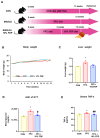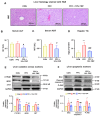Protective Effects of Plum on Liver and Gut Injury in Metabolic Dysfunction-Associated Fatty Liver Disease
- PMID: 39519593
- PMCID: PMC11548136
- DOI: 10.3390/nu16213760
Protective Effects of Plum on Liver and Gut Injury in Metabolic Dysfunction-Associated Fatty Liver Disease
Abstract
Metabolic dysfunction-associated fatty liver disease (MASLD), a persistent liver condition associated with metabolic syndrome, is primarily caused by excessive fructose intake and a typical Western diet. Because there is currently only one approved treatment, lifestyle and dietary interventions are crucial. This study assessed the effects of dietary intervention involving freeze-dried plum (FDP), a natural source of antioxidants containing diverse polyphenols. This study aimed to assess its potential as a protective agent against the gut-liver axis and its therapeutic effects on liver injury and gut permeability issues associated with MASLD. We indicate that 10% FDP intake restored gut barrier proteins and reduced serum endotoxin levels in the MASLD mouse models. Additionally, 10% FDP intake significantly reduced hepatic oxidative stress, lipid metabolism, and fibrosis marker levels. Interestingly, FDP intake significantly reduced the levels of inflammatory cytokine tumor necrosis factor-α and markers of liver damage, such as serum alanine aminotransferase/aspartate aminotransferase and hepatic triglycerides. These results highlight that dietary intervention with FDP that acts as a natural antioxidant may be a significant protective and therapeutic agent against liver and gut damage caused by MASLD.
Keywords: freeze-dried plum (FDP); gut damage; liver damage; metabolic dysfunction-associated fatty liver disease (MASLD).
Conflict of interest statement
The authors declare no conflicts of interest.
Figures





Similar articles
-
Synergistic Effects of Fructose and Food Preservatives on Metabolic Dysfunction-Associated Steatotic Liver Disease (MASLD): From Gut Microbiome Alterations to Hepatic Gene Expression.Nutrients. 2024 Oct 30;16(21):3722. doi: 10.3390/nu16213722. Nutrients. 2024. PMID: 39519554 Free PMC article.
-
Plum Prevents Intestinal and Hepatic Inflammation in the Acute and Chronic Models of Dextran Sulfate Sodium-Induced Mouse Colitis.Mol Nutr Food Res. 2022 Jul;66(13):e2101049. doi: 10.1002/mnfr.202101049. Epub 2022 May 24. Mol Nutr Food Res. 2022. PMID: 35476900
-
Schizandrin A supplementation improves nonalcoholic fatty liver disease in mice fed a high-fat and high-cholesterol diet.Nutr Res. 2019 Apr;64:64-71. doi: 10.1016/j.nutres.2019.01.001. Epub 2019 Jan 11. Nutr Res. 2019. PMID: 30802724
-
Quercetin: A Promising Candidate for the Management of Metabolic Dysfunction-Associated Steatotic Liver Disease (MASLD).Molecules. 2024 Nov 6;29(22):5245. doi: 10.3390/molecules29225245. Molecules. 2024. PMID: 39598636 Free PMC article. Review.
-
Influence of Lipid Class Used for Omega-3 Fatty Acid Supplementation on Liver Fat Accumulation in MASLD.Physiol Res. 2024 Aug 31;73(Suppl 1):S295-S320. doi: 10.33549/physiolres.935396. Epub 2024 Jul 17. Physiol Res. 2024. PMID: 39016154 Free PMC article. Review.
References
-
- Kalhori A., Rafraf M., Navekar R., Ghaffari A., Jafarabadi M.A. Effect of turmeric supplementation on blood pressure and serum levels of sirtuin 1 and adiponectin in patients with nonalcoholic fatty liver disease: A double-blind, randomized, placebo-controlled trial. Prev. Nutr. Food Sci. 2022;27:37–44. doi: 10.3746/pnf.2022.27.1.37. - DOI - PMC - PubMed
MeSH terms
Substances
Grants and funding
LinkOut - more resources
Full Text Sources
Medical

